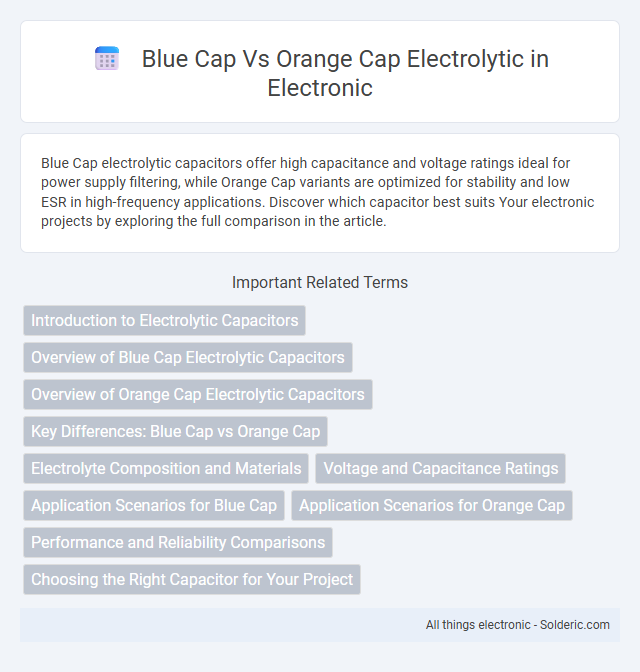Blue Cap electrolytic capacitors offer high capacitance and voltage ratings ideal for power supply filtering, while Orange Cap variants are optimized for stability and low ESR in high-frequency applications. Discover which capacitor best suits Your electronic projects by exploring the full comparison in the article.
Comparison Table
| Feature | Blue Cap Electrolytic | Orange Cap Electrolytic |
|---|---|---|
| Cap Color | Blue | Orange |
| Voltage Rating | Typically 16V to 450V | Typically 16V to 450V |
| Capacitance Range | 1uF to 10000uF | 1uF to 10000uF |
| Operating Temperature | -40degC to 85degC / 105degC | -40degC to 85degC / 105degC |
| Application | General purpose, audio circuits | Power supply filtering, automotive |
| Life Span | 2000 to 5000 hours | 2000 to 5000 hours |
| Leakage Current | Low leakage, stable performance | Moderate leakage, higher ripple current |
| Price | Moderate | Higher |
Introduction to Electrolytic Capacitors
Electrolytic capacitors, identified by their color-coded caps such as blue and orange, are essential for high-capacitance applications in electronic circuits. Blue cap electrolytic capacitors typically feature a lower leakage current and enhanced thermal stability, making them ideal for precision power supply filtering. Orange cap electrolytic capacitors are known for higher ripple current capacity and longer lifespan, suited for demanding industrial environments and audio equipment.
Overview of Blue Cap Electrolytic Capacitors
Blue Cap electrolytic capacitors are renowned for their high capacitance stability and low equivalent series resistance (ESR), making them ideal for power supply filtering and audio applications. These capacitors feature aluminum electrolytes with enhanced durability, providing reliable performance under high ripple current conditions and elevated temperatures up to 105degC. Their compact design and robust construction ensure long-term stability and efficiency in electronics requiring consistent capacitance and low noise levels.
Overview of Orange Cap Electrolytic Capacitors
Orange Cap electrolytic capacitors are known for their robust performance in high-frequency and high-temperature applications, featuring a durable aluminum casing and a non-solid electrolyte that offers excellent capacitance stability. These capacitors provide a wide capacitance range, typically from 1uF to 10000uF, with voltage ratings spanning from 6.3V to 450V, making them suitable for power supply filtering and audio circuits. Their low equivalent series resistance (ESR) and long operational life ensure reliable functionality in demanding electronic environments.
Key Differences: Blue Cap vs Orange Cap
Blue cap electrolytic capacitors typically feature a higher temperature rating and longer lifespan, making them suitable for industrial and automotive applications. Orange cap electrolytic capacitors generally offer higher capacitance values and are often used in consumer electronics for energy storage and filtering. The primary differences lie in their performance characteristics, color-coded identification, and intended usage environments.
Electrolyte Composition and Materials
Blue cap and orange cap electrolytic capacitors differ primarily in their electrolyte composition and materials, impacting performance and reliability. Blue cap capacitors typically use a non-solid, water-based electrolyte designed for general-purpose applications, offering moderate ESR and stability. Orange cap variants often feature solid or hybrid electrolytes, incorporating conductive polymers or organic solvents to enhance conductivity, temperature tolerance, and lifespan, making them suitable for high-frequency and demanding environments.
Voltage and Capacitance Ratings
Blue cap electrolytic capacitors typically offer higher voltage ratings ranging from 25V to 450V, making them suitable for applications requiring stable voltage performance. Orange cap electrolytic capacitors generally feature capacitance values from 1uF to 4700uF, which are optimized for filters and power supply circuits. Your choice between blue and orange caps should consider the specific voltage and capacitance needs of your electronic design to ensure reliability and efficiency.
Application Scenarios for Blue Cap
Blue Cap electrolytic capacitors are ideal for applications requiring high-temperature stability and long life spans, such as power supplies, automotive electronics, and industrial machinery. Their robust dielectric materials ensure reliable performance in demanding environments with frequent temperature fluctuations or high ripple currents. Your projects benefit from Blue Cap's enhanced endurance and low equivalent series resistance (ESR) compared to Orange Cap types, which are often preferred for general-purpose or audio frequency circuits.
Application Scenarios for Orange Cap
Orange cap electrolytic capacitors excel in high-frequency applications due to their low Equivalent Series Resistance (ESR) and superior ripple current handling. They are commonly used in power supplies, audio equipment, and automotive electronics where stable performance under dynamic load conditions is critical. Your circuits benefit from enhanced reliability and efficiency when incorporating orange cap capacitors for signal smoothing and energy storage.
Performance and Reliability Comparisons
Blue cap electrolytic capacitors typically offer higher temperature ratings and longer lifespans, making them ideal for applications requiring enhanced reliability under stress. Orange cap electrolytics often provide better performance in terms of capacitance stability and lower equivalent series resistance (ESR), which benefits high-frequency circuits. Your choice should balance these factors based on the specific demands of performance versus durability in the intended application.
Choosing the Right Capacitor for Your Project
Selecting between a blue cap and an orange cap electrolytic capacitor depends on factors like voltage rating, capacitance value, and temperature tolerance specific to your project needs. Blue caps generally offer higher stability and lower equivalent series resistance (ESR), making them suitable for audio and precision circuits, while orange caps often provide higher ripple current capacity ideal for power supply filtering. Evaluating the operating frequency, physical size constraints, and environmental conditions ensures optimal performance and longevity in your chosen capacitor.
Blue cap vs orange cap electrolytic Infographic

 solderic.com
solderic.com